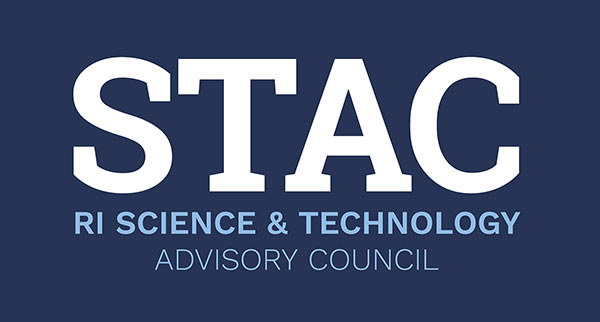Six interdisciplinary research teams were selected by the review panel to receive funding, totaling $479,358, from the Science & Technology Advisory Council (STAC) this year. Research projects directly address the RI NSF EPSCoR program themes of:
- Assessing and enhancing the health and resilience of Narragansett Bay to both natural and anthropogenic stressors.
- Evaluating existing models and/or developing new innovative models for the Narragansett Bay ecosystem.
- Improving visualization of complex information integrating climate change impacts on the RI coastal ecosystem.
Approved Proposals
Validating Surface Enhanced Raman Spectroscopy for Remote Water Sensing ($80,000)
- Geoffrey Bothun, Professor of Chemical Engineering, University of Rhode Island
- Stephen O’Shea, Professor of Chemistry, Roger Williams University
The development of robust, ultrasensitive water monitoring systems is critical for enhancing our understanding of water quality dynamics in the face of both natural and anthropogenic stressors. Efforts must focus on integrating innovative technologies to provide real-time, actionable data that protect human health and preserve the integrity of aquatic ecosystems. This collaborative proposal describes a platform detection technology and strategies for validation focusing on the detection of limiting nutrients in drinking water and in coastal marine environments with high saline content. The focus on limiting nutrients is motivated by an increase in nutrient exposure to world populations over the last 50 years, the adverse health risks they pose, and the negative ecological and economic impacts in RI.
Air-Sea Interactions Guide Offshore Wind Farm Ecosystem Impacts ($79,983)
- Baylor Fox-Kemper, Professor of Earth, Environmental, and Planetary Sciences, Brown University
- Nick Pizzo, Assistant Professor of Oceanography, University of Rhode Island
This project will explore how wind farms influence air-sea dynamics, stratification, and thus ecosystem responses under varying seasonal and diurnal conditions. Catalytic Nature of the Project: The research will directly inform sustainable offshore wind energy practices and contribute to broader effects in understanding and communicating the impacts and limits on impacts of these structures on marina ecosystems.
Predicating Elemental Stoichiometry and Macromolecular Allocation in Narragansett Bay Phytoplankton ($80,000)
- Keisuke Inomura, Assistant Professor, University of Rhode Island
- Anastasiia Rain, Associate Professor, Rhode Island School of Design
Elemental stoichiometry (Carbon:Nitrogen:Phosphorus ratios or C:N:P) is a basis for biogeochemical cycling and the ecosystem in Narragansett Bay and affects fish productivity, which is critical to the local economy and beyond. Elemental stoichiometry is strongly linked to macromolecular allocation (biomass allocation to carbohydrates, proteins, lipids, nucleic acid, chlorophyll) because each macromolecule has distinct C:N:P. However, the patterns and controls of the elemental stoichiometry and macromolecular allocation in Narragansett Bay are still an open question. To fill this gap, we will be combining the physiological model of phytoplankton and Narragansett Bay physical and biogeochemical simulation, predicting the pattern of elemental stoichiometry and macromolecular allocation across Narragansett Bay and analyzing their control. The model results will be tested with data obtained from autonomous vehicles and existing datasets. We will develop an intuitive web application to convey the research outcomes to broader audiences through a series of outreach events.
UAV-based Fiber Optic Sensing and Sampling for Underwater Applications ($80,000)
- Brennan Phillips, Associate Professor of Ocean Engineering, University of Rhode Island
- Matt Jewell, Founder and CEO, Juice Robotics
This project aims to design, develop and test a novel UAV based system architecture for subsea sensing and sampling using fiber optic microtethers. It builds upon two recent US patents led by URI that enable a small payload UAV to carry significant lengths of fiber optic microtether, developed by Nautilus Defense LLC, on a lightweight winch system. This, combined with miniaturized subsea components currently manufactured and marketed by Juice Robotics LLC will comprise a live, high-bandwidth link between the offshore/underwater environment and land-based control stations.
Enhancing Rhode Island Shellfish Resilience to Anthropogenic Stressors through a new Aquaculture Technological Approach ($79,412)
- Coleen Suckling, Associate Professor of Aquaculture and Fisheries, University of Rhode Island
- Reuban Macfarlan, Principal Marine Biologist, RI Department of Environmental Management
Rhode Island shellfish growers face challenges in managing biofouling, increasing resilience to environmental changes, and improving aquaculture’s social acceptance. This project will catalyze, develop and accelerate innovative aquaculture technology, integrating native purple sea urchins (PSUs) with Eastern oyster populations in RI waters to naturally control biofouling, reduce labor and costs, and increase social acceptance. Initial trials show promising results for market-quality oysters and minimizing farm effort, the latter often met with negative public perceptions of farm-related noise and air quality. To scale this approach, the project will optimize integration methods, establish hatchery techniques and timings, and develop environmentally sustainable management practices to sustain supply and enhance the health and resilience of RI marine species to natural and anthropogenic stressors.
Characterizing Benthic Foraminifera for Coastal Resilience Biomonitoring ($79,962)
- Ying Zhang, Associate Professor of Computational Biology, University of Rhode Island
- Kenneth Raposa, Research Coordinator of Salt Marsh Ecology, RI Department of Environmental Management
Among various anthropogenic-driven stressors, sea-level rise (SLR) and increasing flooding and storm surges are major threats to coastal ecosystems. Restoration approaches such as thin-layer placement (TLP) of sediment are promising adaptive strategies for providing elevated ground and promoting vegetation growth in salt marshes. However, assessing the outcomes of TLP restoration requires long-term monitoring of both restored and unrestored sites. Previous efforts of TLP monitoring in tidal marshes have focused on above-ground indicators, leaving significant knowledge gaps in the monitoring of sediment conditions. Here, we propose to develop quantitative indices based on communities of benthic foraminifera, a group of eukaryotic microorganisms that are known for their abundance in coastal sediments and rapid responses to environmental changes. The quantitative indices will be calibrated based on measurements of sediment conditions and vegetation. Indices with strong correlations with vegetation health will be applied for biomonitoring and assessing salt marsh resilience both before and after TLP restoration.
